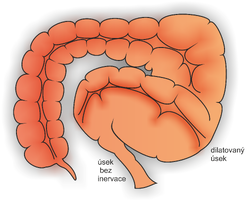Congenital Megacolon
From WikiLectures
Congenital aganglionic megacolon (Hirschsprung's disease) is caused by the absence of intestinal innervation that affects the internal anal sphincter and the adjacent proximal segment.[1]
Epidemiology[edit | edit source]
- It is the most common cause of lower GIT obstruction in newborns;
- its incidence is 1:5000 live births;
- boys are affected 4 times more often than girls;
- and it may be associated with other birth defects (i.e: trisomy 21 or medullary thyroids carcinoma).[1]
Etiopathogenesis and Pathophysiology[edit | edit source]
- a disorder of neuroblast migration from the proximal to the distal intestine with consequent absence of ganglion cells in the intestinal wall;
- histologically: absence of Meissner's and Auerbach's plexus with hypertrophic nerve endings and high concentration of acetylcholinesterase;
- short-segment disease aka the classical form(75%): aganglionosis in the rectosigmoid colon;
- long-segment disease (10%): aganglionosis in the whole colon
- ultra-short segment disease: aganglionosis in the rectum that is 1-3 cm long;
- the aganglionic region is permanently contracted (inhibiting neurons are missing) which causes a functional obstruction → thus, the healthy intestine dilates above it and hypertrophies to form a megacolon. [1]
Clinical Picture[edit | edit source]
- in 90% of cases, manifestation begins immediately after birth;
- milder forms: chronic constipation, growth failure, gradually developing abdominal distension with an increase in pathogens and symptoms of enterocolitis to sepsis;
- the onset of difficulties is typical in infancy (often after the introduction of non-dairy foods): increased tone of the internal sphincter, small volume of stool during defecation, or no defecation;
- in ultrashort segment disease, stools accumulate in the rectum and the sphincters gradually weaken. Thus smearing + paradoxical diarrhea (soiled laundry).[1]
Diagnosis[edit | edit source]
- irigography – after previous emptying of the intestine by enemas, delayed evacuation, transition zone between the narrow distal aganglional segment and the proximally dilated section of the intestine; defecogram;
- anorectal manometry - measurement of anal pressure when inflating a balloon in the rectum (anal pressure does not decrease or it paradoxically increases);
- rectal biopsy - may be false negative in the ultrashort segment. [1]
Therapy[edit | edit source]
- surgical solution: good prognosis, most patients have preserved continence.[1]
Complications[edit | edit source]
- Toxic megacolon - can lead to sepsis with a risk of secondary meningitis or intestinal perforation.[2]
Notes[edit | edit source]
- Megacolon idiopaticum : a disorder of vegetative innervation - the disparity between the sympathetic and parasympathetic .
- Megacolon symptomaticum : dilatation above the stenotic site - eg. congenital stenosis, scar after surgery…[3]
References[edit | edit source]
Related Articles[edit | edit source]
References[edit | edit source]
- ↑ a b c d e f LEBL, J – JANDA, J – POHUNEK, P. Klinická pediatrie. 1. edition. Galén, 2012. 698 pp. pp. 308-309. ISBN 978-80-7262-772-1.
- ↑ MUNTAU, Ania Carolina. Pediatrie. 4. edition. Grada, 2009. pp. 367-368. ISBN 978-80-247-2525-3.
- ↑ BENEŠ, Jiří. Studijní materiály [online]. [cit. 2010-04]. <http://www.jirben.wz.cz/>.



